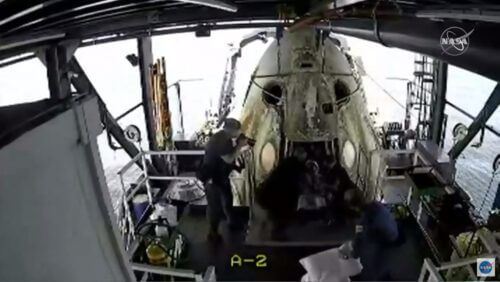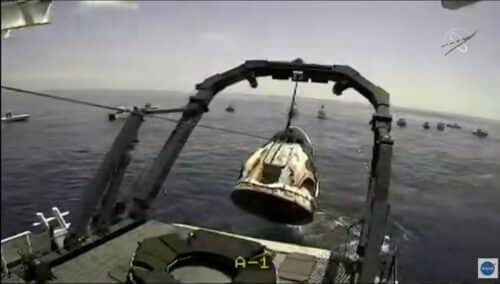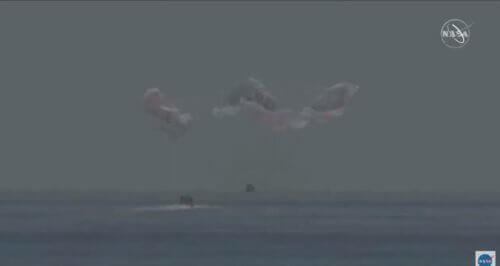The landing was smooth and so was the rescue, which lasted about an hour and a quarter, was successful * SpaceX's first commercial flight is expected at the end of September

Update 23:10 - The two astronauts were ejected from the Dragon Endeavor spacecraft about an hour and a quarter after landing. This despite the fact that they had already been on the rescue ship for almost an hour. This is to allow the crew on the ship to make sure that there are no traces of the toxic fuel materials around the spacecraft.
Update 22:16 p.m. – The capsule was put on the rescue ship


American astronauts Doug Hurley and Bob Benken landed safely today (21:48 Israel time) in SpaceX's Dragon-Endeavour spacecraft. The spacecraft's parachutes opened as it approached the ground over the Gulf of Mexico, not far from the west coast of Florida. About a quarter of an hour before landing, contact with the spacecraft was lost for a few minutes when it entered the atmosphere. During the descent, the astronauts experienced a gravity of 3.5G. The weather was excellent and the water looked as smooth as glass.
The astronauts are supposed to leave the cabin when they board the Go Navigator rescue ship about an hour after disembarking from the speedboats working to rescue them.
The method of landing is basically a return to the Apollo days of the sixties and seventies. Before the shuttle period, they flew in disposable capsules that at the end of the mission landed using parachutes in the sea. The Russians have always continued to land spacecraft using this method, but they prefer landing on land - in the steppes of Kazakhstan.
The historic launch took place on May 30 from NASA's Kennedy Space Center in Florida, in Simen. But while the launch was a nail-biting experience to watch, the re-entry will be even more dangerous – a tense moment for mission control. The founder of SpaceX, Elon Musk, said that re-entry is indeed his "biggest concern".
Banken and Hurley arrived at the space station on May 31, following a successful launch on May 30 aboard SpaceX's Falcon 9 launcher from NASA's Kennedy Space Center in Florida on a mission known as Demo-2 (an earlier NASA mission was unmanned and passed successfully). It was the first time that a commercial space company flew humans into orbit around the Earth. Ahead of the landing, SpaceX founder Elon Musk said that re-entering the Earth's atmosphere is indeed his "greatest concern".
Their return completes the test flight for the first commercially owned and operated crewed spacecraft under NASA's Commercial Crew Program. The Commercial Crew Program works with the US aerospace industry to develop safe, reliable and cost-effective crew transportation systems that will transport astronauts using US launchers and spacecraft from US soil to the International Space Station and back.
Since the retirement of the space shuttles in 2011, the US has been dependent on Russia and the Soyuz spacecraft (as well as the launchers of the same name). The price of the launch has increased over the years and in recent years stood at 30 million dollars per seat.
This is SpaceX's final test flight and it provides data on the performance of the Falcon 9 launcher, Crew Dragon spacecraft and ground systems, as well as operations in orbit, docking, parachute landing and rescue of the spacecraft from the sea, near the coast of Pasquale, Florida. After analyzing the data, NASA will announce the licensing of SpaceX's space flight system for regular flights that will take astronauts to and from the space station. SpaceX is preparing the next launcher and spacecraft for the first launch mission following NASA approval.
At the same time, another company that received a concession from NASA to launch humans is Boeing, however, it is not yet ready. Its Starliner spacecraft was successfully launched for an unmanned test in December 2019, but it failed to reach the space station and Boeing had to leave it in orbit around Earth and land it earlier than planned.
The idea of the commercial crew program is to direct resources to NASA to build Orion spacecraft, which will fly humans beyond Earth's orbit, while private companies will maintain the flights to low orbit, at this point to the International Space Station. In the future maybe also for space hotels. In the more intermediate stage, SpaceX can use their excess capacity to launch astronauts to the space station and add space tourists to them.

One response
What is a nail biting experience?
…”But while the launch was a nail-biting experience to watch.”